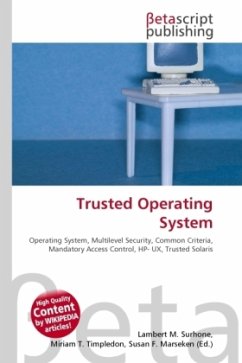
Trusted Timestamping
Versandkostenfrei!
Versandfertig in 6-10 Tagen
26,99 €
inkl. MwSt.

PAYBACK Punkte
13 °P sammeln!
High Quality Content by WIKIPEDIA articles! The idea of timestamping information is actually centuries old. For example, when Robert Hooke discovered Hooke's law in 1660, he did not want to publish it yet, but wanted to be able to claim priority. So he published the anagram ceiiinosssttuv and later published the translation ut tensio sic vis (Latin for "as is the extension, so is the force"). Similarly, Galileo first published his discovery of the phases of Venus in the anagram form. A modern example is the case of an industrial research organization that may later need to prove, for patent pu...
High Quality Content by WIKIPEDIA articles! The idea of timestamping information is actually centuries old. For example, when Robert Hooke discovered Hooke's law in 1660, he did not want to publish it yet, but wanted to be able to claim priority. So he published the anagram ceiiinosssttuv and later published the translation ut tensio sic vis (Latin for "as is the extension, so is the force"). Similarly, Galileo first published his discovery of the phases of Venus in the anagram form. A modern example is the case of an industrial research organization that may later need to prove, for patent purposes, that they made a particular discovery on a particular date; since magnetic media can be altered easily, this may be a nontrivial issue. One possible solution is for a researcher to compute and record in a hardcopy laboratory notebook a cryptographic hash of the relevant data file. In the future, should there be a need to prove the version of this file retrieved from a backup tape hasnot been altered, the hash function could be recomputed and compared with the hash value recorded in that paper notebook.












